G.Skill Trident Z5 RGB DDR5-6000 32GB Dual-Channel Kit Review
The cost justification of sticking Intel’s latest 12th-gen core processors with DDR4 begins to go away as DDR5 component availability improves. Where just a few months ago builders could expect to pay a 500% premium for the new tech, G.Skill’s latest DDR5-6000 costs only twice as much as the same capacity DDR4-4000 kit we tested a few months ago. As DDR5 dual-channel kits are expected to cost at least $50 more to produce even after prices normalize, today is probably a reasonable time for high-end builders to consider making the switch.
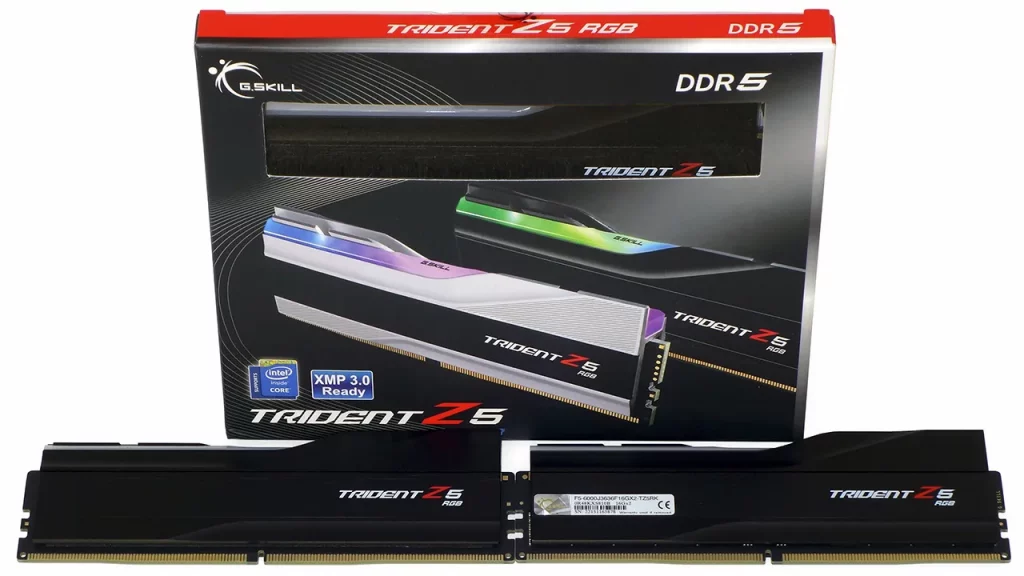
Get it at Amazon

(click for availability)
G.Skill’s part number F5-6000J3636F16GX2-TZ5RK Trident Z5 RGB DDR5-6000 kit comes with two 16GB RGB DIMMs and a sticker approximately the size of a ‘90s-era case badge. Each kit automatically switches from DDR5-4800 C40 to its rated DDR5-6000 C36 after enabling XMP in motherboard BIOS. While the 36-36-36 timings are strongly competitive at this data rate, we have some concerns about the performance impact of its 96-cycle tRAS. Today’s performance analysis will show how or whether performance is impacted.

We didn’t need to risk damaging the memory by removing its heat spreaders, as CPU-Z shows G.Skill’s DDR5-6000 using the same Samsung ICs as Corsair’s DDR5-5600. Increased the voltage to 1.35V (from Corsair’s 1.25V) is one way in way G.Skill achieves its higher data rate, but we barely reached DDR5-6000 on Corsair’s kit by doing the same. Other factors include a completely different baseline timing set from which our motherboard firmware configures advanced timings, along with possibly better IC selection via “binning”. Binning is a process in which ICs (aka “chips) are sorted to find the best of the batch.

Factory set in Rainbow mode, G.Skill’s Trident Z5 RGB kits rely on motherboard RGB software for other colors and patterns, and are compatible with Asus Aura, Gigabyte RGB Fusion, MSI Mystic Light, and ASRock Polychrome Sync. A lifetime limited warranty covers both the memory and its RGB function, with technical support available via online forum, telephone, and email.
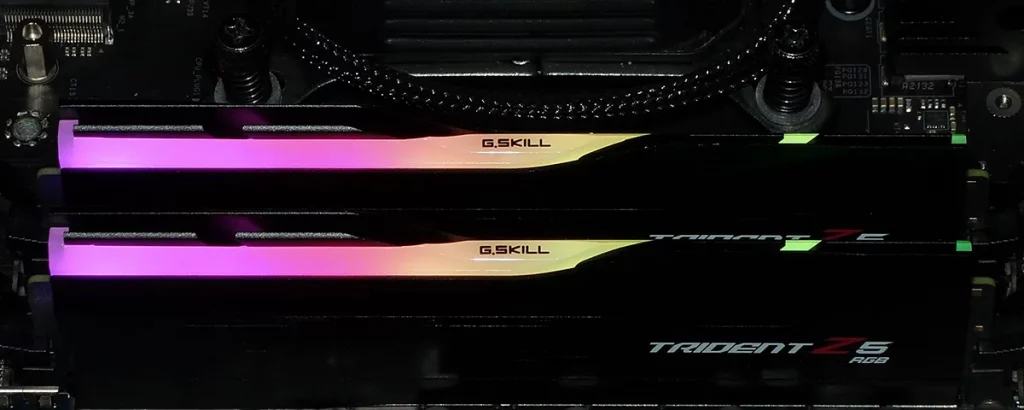
The packaging portions of the G.Skill (-TZ5RK ) and Adata (-CLARBK) model numbers have been appended from our charts due to the product code exceeding title space.
| Test Configuration | |
| CPU | Intel Core i9-12900KF: 16C/24T, 3.2-5.2 GHz, 30 MB L3 Cache, LGA 1700 |
| CPU Cooler | Alphacool Eisblock XPX CPU, VPP655 with Eisbecher D5 150mm, NexXxoS UT60 X-Flow |
| Motherboards | DDR5: ASRock Z690 Taichi, BIOS 1.43 DDR4: ASRock Z690 Extreme WiFi 6E, BIOS 2.02 |
| Comparison RAM | Corsair CMT32GX5M2X5600C36 2x 16GB (32GB) DDR5-5600 36-36-36-76 1.25V Adata AX5U5200C3816G-CLARBK 2x 16GB (32GB) DDR5-5200 38-38-38-76 1.25V Crucial CT2K16G48C40U5 2x 16GB (32GB) DDR5-4800 40-39-39-77 1.10V Mushkin MLA4C400JNNM16GX2 2x16GB (32GB) DDR4-4000 18-22-22-42 1.35V |
| Graphics | Gigabyte GeForce RTX 2070 Gaming OC 8G: 1410-1725 MHz GPU, GDDR6 |
| Power | be quiet! Dark Power Pro 10 850W: ATX12V v2.3, EPS12V, 80 PLUS Platinum |
| Hard Drive | TOSHIBA OCZ RD400 256GB NVMe 1.1b SSD |
| Sound | Integrated HD Audio |
| Network | Integrated Wi-Fi |
| Graphics Driver | GeForce 496.49 |
Overclocking & Latency Tuning
G.Skill’s Trident Z5 DDR5-6000 starts at the same frequency where its fastest competitor stopped, so it was always going to be the highest-frequency kit. Our efforts to reach DDR5-6400 failed, but we did get it to DDR5-6200 at the same CAS 40-40-40-84 settings that we used to try to push the other kits that far.
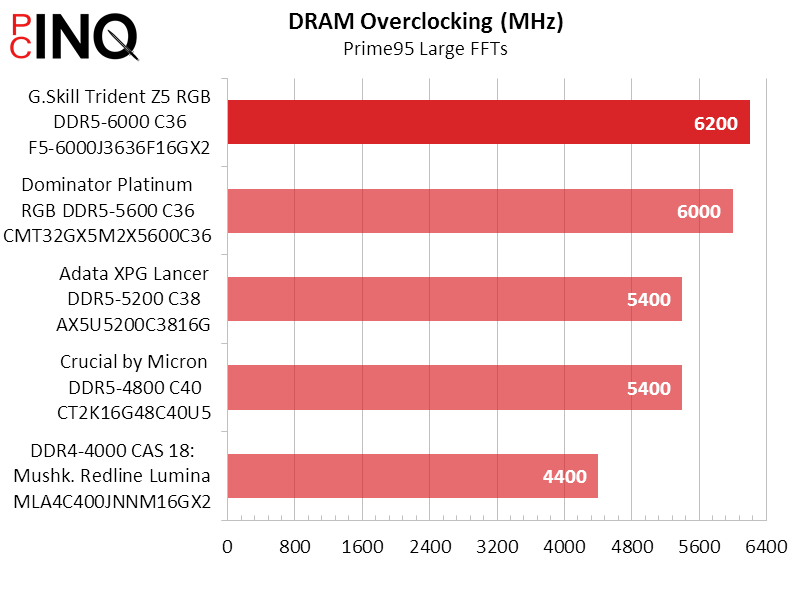
None of our DDR5 kits have yet reached the 6400 MHz data rate (3200 MHz clock rate), but underclocked Trident Z5 DDR5-6000 withstood being tightened to CAS 31 at DDR5-5600.
| Lowest Stable Timings | |||
| DDR5-6400 | DDR5-5600 | DDR5-4800 | |
| G.Skill Trident Z5 RGB DDR5-6000 C36 F5-6000J3636F16GX2 |
X | 31-31-31-62 (2T) | 28-28-28-56 (2T) |
| Dominator Platinum RGB DDR5-5600 C36 CMT32GX5M2X5600C36 |
X | 34-34-34-68 (2T) | 28-28-28-56 (2T) |
| Adata XPG Lancer DDR5-5200 C38 AX5U5200C3816G |
X |
X | 36-36-36-72 (2T) |
| Crucial by Micron DDR5-4800 C40 CT2K16G48C40U5 |
X | X |
36-36-36-72 (2T) |
It might take some time for any DDR5 kits we test to reach the magical 10ns mark that we’ve typically used to define low-latency memory, but an attempt to reach CAS 30 at the 6000-kit’s rated data rate got us all the way down to 34-34-34-68. And that made us again question why this CAS 36-rated kit came programmed with such an excessive 96-cycle tRAS.
Performance
Sandra shows identical bandwidth between Trident Z5 DDR5-6000 and Dominator Platinum DDR5-5600, though the higher-rated kit at least has a small advantage in Sandra Latency. It also had superior overclocked performance scores across the board.
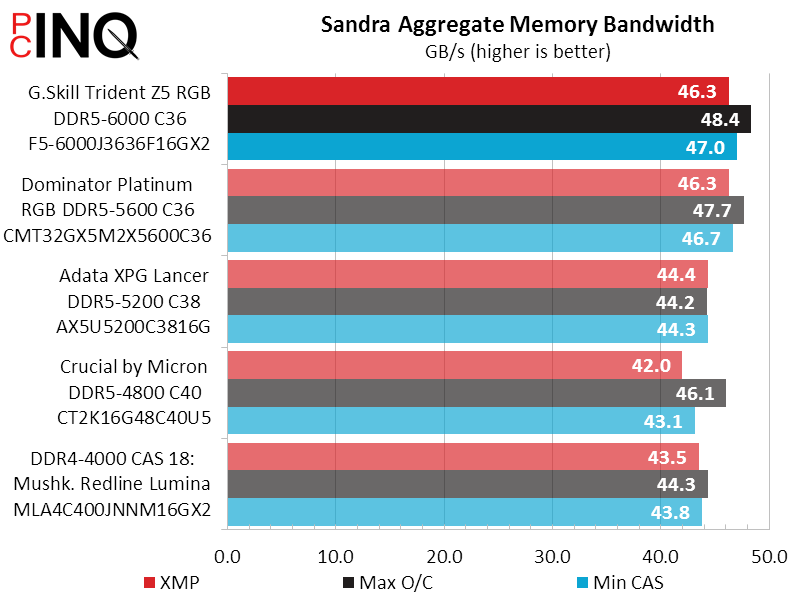
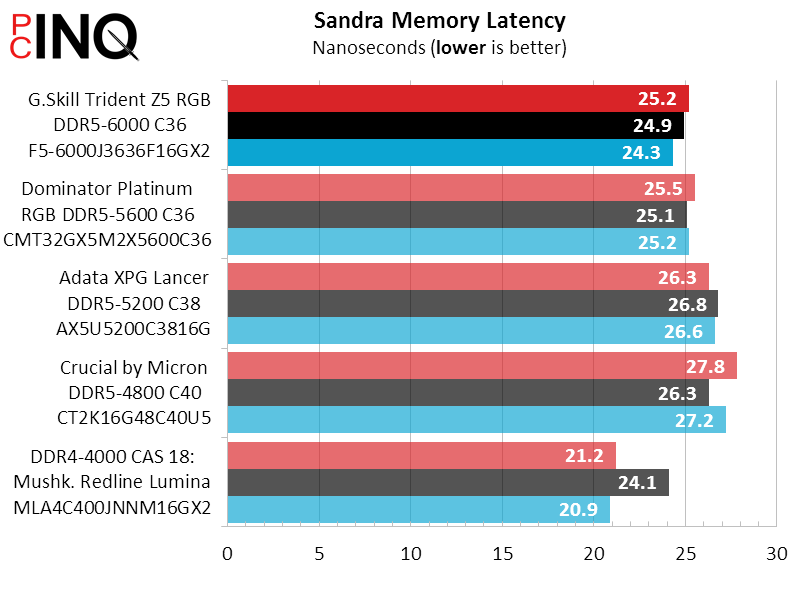
Unlike Sandra, AIDA64 shows a significant bandwidth advantage for the DDR5-6000 kit, as well as superior latency. We should remind less-familiar readers that memory timings are specified in clock cycles, where higher memory frequencies result in lower cycle times and thus fewer nanoseconds for any stated CAS.




DDR5 pushes 3DMark to the point of limited returns, but we still see minor improvements from faster kits. Compare F1 2021, where previous tests have shown even less gain when going beyond DDR4-3600.


We saw someone comment in a user group that DDR5 is pointless unless you’re planning on compressing files in 7.Zip all day…and it’s true that 7.Zip is the best-optimized application we’ve seen to show Trident Z5 RGB DDR5-6000’s advantage.


While our concerns about the performance impact of its high tRAS setting only appeared to impact SiSoftware Sandra synthetic benchmark, we were pleased to find that this default setting was not needed to maintain stability on our test platform. Moreover, Trident Z5 RGB DDR5-6000 performed flawlessly in both default XMP and manually-optimized configurations, and is currently available at a price that matches our next-fastest reviewed kit. We expect the current $350 discount price to become permanent by the end of May, making part number F5-6000J3636F16GX2-TZ5RK a solid value within the high-spec market.
| Pros: | Cons: |
|
|
| The Verdict: | |
|
Priced to compete with the DDR5-5600 kits of other brands, G.Skill’s Trident Z5 RGB DDR5-6000 has the performance and adjustability to make it our top choice for high-spec kits. |
|

